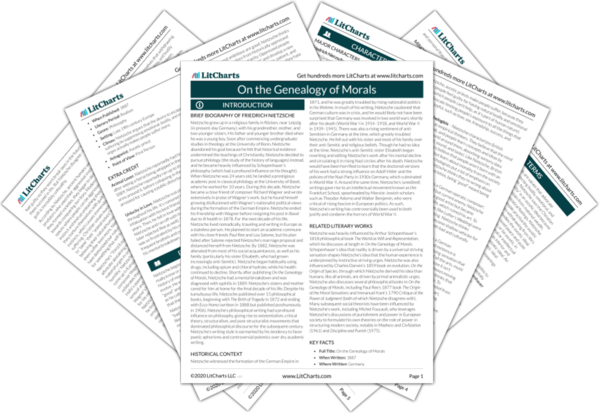Nietzsche uses the metaphor of “bad air”—essentially, the stench of diseased, rotting corpses—to represent 19th-century European culture’s stagnant, regressive state. Nietzsche thinks that European culture stunts humanity, because its moral code encourages people to be gentle, passive, and charitable. The moral code also depicts aggressive urges, emotional intensity, bodily desires, and adventurousness as “sinful” or “evil.” To Nietzsche, all these supposedly “evil” tendencies are innately human instincts, and they’re all the things that connect people with the joys of life—as such, people who suppress their instincts are aren’t really living. Thus, according to Nietzsche, people who obey Europe’s moral code are essentially corpses who are living a deadened version of life, giving off a stench, or “bad air,” that infects the whole of society with a similar sense of emptiness, sickness, and decay.
Bad Air Quotes in On the Genealogy of Morals
What is it precisely which I find intolerable? That which I cannot deal with alone, which makes me choke and faint? Bad air! Bad air! That something foul comes near me; that I must inhale the putrid odour of the entrails of a rotten soul!
Nietzsche uses this metaphor because he believes that the prevailing moral code in modern Europe characterizes aggression and power-seeking behavior as evil. To Nietzsche, however, these are fundamental aspects of human nature inherited by modern people from our ancient ancestors (predators who instinctively derived satisfaction from hunting and killing). He thinks that modern European culture forces people to repress their aggressive instincts, which makes them suffer, and that this suffering prevents them from thriving and experiencing life with joy and stunts humanity. He symbolizes this stultification by imagining that Europe isn’t full of healthy, happy people who are actively living as fully realized human beings. Instead, it’s full of people who are forced to hold back a part of themselves, so they aren’t really living but suffering and dying, and their corpses are giving off “bad air.” The metaphor of bad air thus represents humanity’s regression or decline in modern Europe.

Unlock explanations and citation info for this and every other On the Genealogy of Morals quote.
Plus so much more...
Get LitCharts A+









